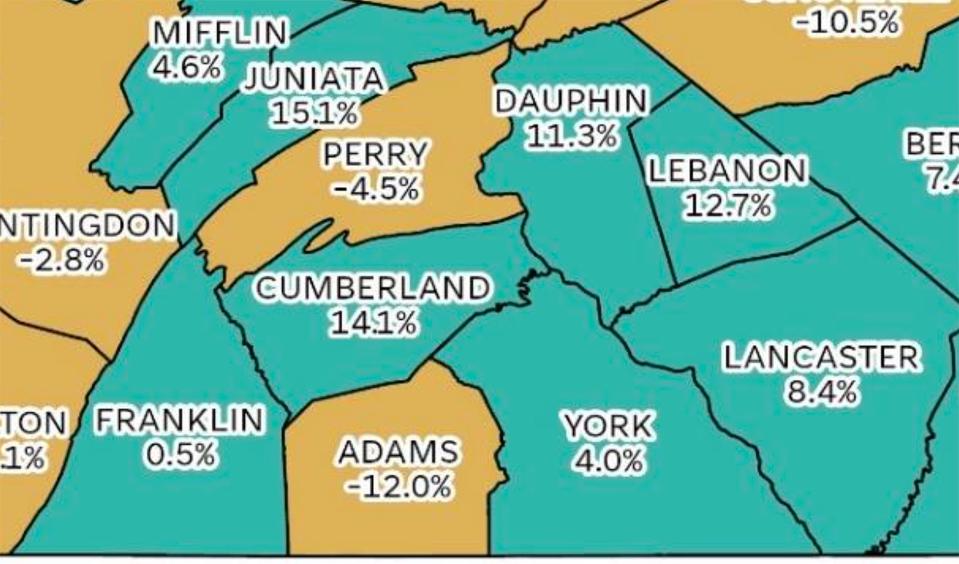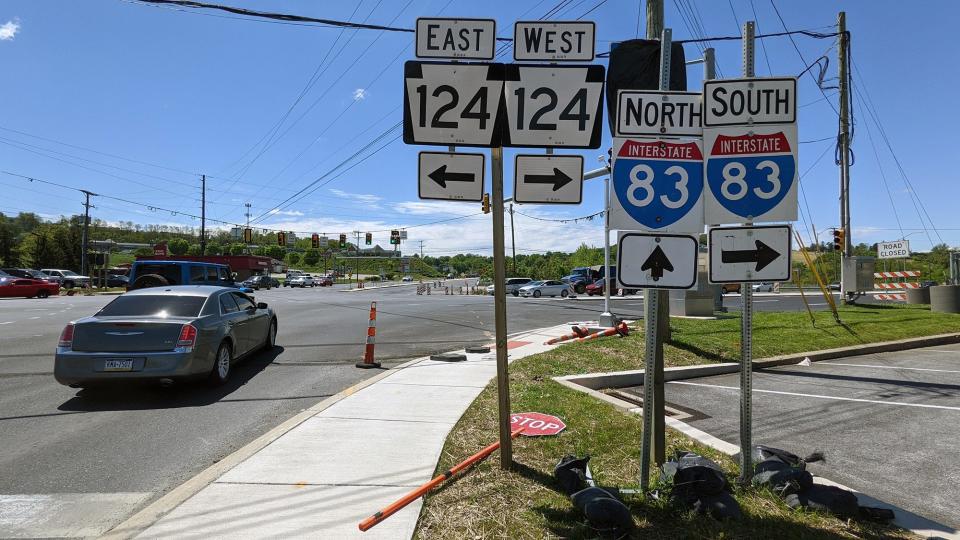A tale of 2 counties: York to grow over 30 years, Adams to shrink: What it means for you
The Center for Rural Pennsylvania recently released Pennsylvania's population projections through 2050, showing that York County is expected to grow, while Adams County is expected to decline.
According to the report, the population in rural Pennsylvania counties is expected to shrink by 5.8% overall, and the projected total growth rate for the state over the next 30 years will be 1.6%.
When looking at York and Adams counties specifically, there is an estimated growth of 4% for York and a projected 12% decline for Adams.
At the beginning of 2020, Adams County had a population of 103,779. By 2050, that number will be 91,297 if these projections are correct. In 2020, York County had a population of 456,692, and it will have a population of 475,084 by 2050, based on these projects.

According to the report, one of the biggest drivers of these population changes is the increased age of the population over the next 30 years.
"As the Baby Boomer generation continues to retire and age, the population of residents over 65 is going to sharply increase. This trend, contrasted with a declining statewide birth rate, means that rural Pennsylvanians over the age of 65 will soon outnumber those under 20," according to the report.
Here's what these changes could mean for York and Adams counties:

Impact on planning and development
Felicia Dell, director of the York County Planning Commission, said that a 4% growth rate for York County is "a little higher than average over the last couple of Census cycles, but not surprising. It is in the realm of typical growth we have been absorbing for quite a while."
Anne Walko, senior planner for the commission, said based on their current projections, York County's population will be at 504,958 in 2030, at 542,340 in 2040 and at 581,738 in 2050 − a 7.26% increase from 2010.
"Although York County is served by major roadways (Route 30, Interstate 83, Route 15 and the Turnpike) and has a significant urbanized area, we are still classified as a rural county by some standards due to our significant agricultural economy and beautiful natural features," Dell said. "Over the decades, York County has consistently grown in population even when the state has not. This is probably due to many factors such as our proximity to Baltimore, Harrisburg and Lancaster, who all have commuter sheds that include parts of York County. In other words, people live in York County due to the community, landscape, housing prices and other amenities, but work in the surrounding areas outside of York County."
Dell added that, during her lifetime, York County has always seen a growing population.
"For a county such as ours that has seen steady growth, the impact is felt in many areas. Population growth leads to an increase in housing, a need for more community services, more traffic, more commerce, expanding schools, etc.," she said. "The trick is to grow across multiple sectors of the community. You want the local economy to be diverse so there are a variety of job opportunities to support a growing population. A diverse local economy also provides diversity in the tax base which can provide some insulation from crazy economic swings."
A county's population plays a crucial role in community planning as it provides essential data and insights that inform various aspects. For example, population directly influences resource allocation for public services, and it impacts planning and developing infrastructure such as roads, public transportation and utilities.
Knowing the population size and distribution is critical for emergency preparedness. It helps in developing evacuation plans, determining the capacity of emergency shelters, and allocating resources for disaster response.
Population data enables planners to anticipate the demand for housing, and planners use demographic data to designate areas for residential, commercial and industrial purposes, ensuring that land use aligns with the needs and preferences of the community.
Population data also helps identify the labor force, consumer markets and potential business opportunities.
Impact on healthcare
One of the largest impacts this type of shift will have is on healthcare.
Michelle Del Pizzo, president of UPMC Memorial York, said the hospital system is already being proactive and looking ahead to how to serve the changing community in the years to come.
"Sure, we look at the population of a community and the trends there, but really we look at what that community needs, rather than the number of people in the community," she said. "A population change matters for certain services, and we do look at birth rate versus say the retirement rates to look at what types of long-term care will be needed by those we serve as they age."

One of the ways UPMC does that, she added, is to meet with partners to offer continuing care and services to the elderly populations they serve so that patients who need extra care leave the hospital when they need to, but they also have support in place once they leave.
This is a sentiment echoed by Niki Hinckle, senior vice president of WellSpan.
"We have to be more intentional in thinking about not so much as an individual hospital, so that when people need care we can provide services across the system, not just in this one county," she said.
Larger cities will often have larger hospital systems, she said, but WellSpan works to make its services available to everyone who needs them. To do this, it has started things such as a mobile mammography vehicle that goes into rural communities to meet patients where they are.
Being proactive also means planning for having enough staff. Del Pizzo said that this is the first time in her 25-year healthcare career that she's seen a hospital system go to the schools to talk to kids in middle and high school about selecting a career in healthcare. She said UPMC has also partnered with colleges to get healthcare students in a work/learn program.
"We find that a lot of people don't know what all it takes to run a hospital system. It's more than doctors and nurses. We have administrative staff, scientists in our lab, and much more," she said. "So when we go into these schools and teach kids about what careers they can have in healthcare, we hope to start seeing more people entering the healthcare field."
Hinckle said that when juggling everything involved in running a hospital system, you sometimes have to get creative. For WellSpan, it's just as important to promote from within and train and retain staff as it is to bring on new staff. That is why it offers internal training programs and other opportunities for continuing education and advancement. Vicky Diamond, senior vice president of WellSpan’s central region, said that being part of healthcare system affords the ability to use "resources within our system to support any population in any county we serve."Diamond said WellSpan is already providing telehealth consults and virtual nursing, where nurses help facilitate patient admission. They even use virtual sitters. "Many people, especially as you age, are at greater risks of falls, and virtual sitting puts eyes on the patient all the time, rather than waiting on nurses to make rounds and check on them," she said. Diamond said that hospitals "used to have standalone buildings, but so much of what we are doing today involves talks of how and when we can provide care." That includes extending urgent care hours, offering more online services and providing mobile units to meet various needs.
This is something Diamond sees continuing and growing as the landscape of healthcare grows, and it's unlikely to change based on a county's population, particularly because WellSpan has so many patients from other areas who travel to its centers for care.
WellSpan York Hospital is currently undergoing an expansion that was listed among 10 largest in the state. That expansion will include an eight-story surgical and critical care tower with state-of-the-art medical technology. The expansion is expected to be complete in 2025.
UPMC Memorial opened a new hospital in West Manchester Township in 2019.
The impact on education
A population decline or increase can have a huge impact on education because population is a determining factor in funding and the programs offered.
"A portion of a school district’s funding stems from the number of students enrolled, so with fewer students, there will be less funding received," said Brad Perkins, director of public safety, public relations and child accounting for the Dover Area School District.
Perkins added that fewer students could lead to a consolidation of classrooms, reduction in staff and "often the reduction of special programs at the schools or athletic programs that can be offered."
"Depending on the school district’s current transportation routes, it may mean longer bus rides for some students if busing needs are reduced," he said.
On the flipside of that is an increase in population, which means the district must hire more teachers to address the growth, and it could spend more for technology and curriculum materials.
"In addition, there may need to be an increase in paraprofessional and specialized staff depending on the needs and ages of the students. If the district has not appropriately accounted for the new growth, there may be additional transportation needs, such as other buses and drivers or planning new routes," he said.

The impact on housing
Housing will obviously be affected by a population's increase or decline, and that's especially true in a region where there's a housing shortage.
"The ongoing population growth is exerting increasing pressure on inventory levels in York County. Currently, the supply of inventory stands at less than two months," said Shanna Terroso, executive officer with the Realtors Association of York & Adams Counties. "The confluence of limited supply and heightened demand is contributing to a continuous upward push on housing prices."
As of the end of November, the median home sale price in York County was $263,500, marking an 8% increase from 2022. Housing prices have surged by over $63,000 since 2020, reflecting a 31% increase, Terroso added.
"Given the scarcity of available land for new construction, there is a crucial need to maintain focus on revitalizing our boroughs and urban areas to effectively address future housing requirements," she said.
In Adams County, the projected decrease is unique, she said, "considering that Adams County has experienced growth in 9 out of the past 12 years" and looking at the projection that all of "the counties surrounding Adams County are anticipated to undergo positive population growth."
RAYAC reported that a total of 964 homes were sold in Adams County in November 2023, a 13% decrease from 2022. The median sales price in Adams County was $285,000, a 2% increase over last year. Homes stay on the market an average of 11 days, according to the RAYAC report.
This means that Adams County has a little more inventory in regard to housing, but a decline in population could alleviate the strain more.
The impact on economic development
"The growth of our rural communities can lead to supporting the workforce needs of some of our leading job sectors, manufacturing, healthcare, retail and construction, which as you talk to any employer is the top need," said Kevin Schreiber, president and CEO of the York County Economic Alliance. "However, the age of the population in our more rural areas may be deemed less of a boost to the workforce and may lead to a greater need for both senior housing communities and increasing demand for healthcare providers."

In a Housing Needs and Conditions Assessment, released by the YCEA in July 2023, it was noted that in the next decade more than a quarter of the local workforce will become senior citizens.
"We need to ensure we are balancing our population to serve the needs of our community," Schreiber said. "This is done so in rural areas by stabilizing rural municipalities and businesses. Municipalities and our organization will need to find ways to create easier processes for businesses to grow, such as reviewing existing policies that lead to cohesion and pathways for our rural areas to be competitive."
That is already being done by highlighting York as a center for agriculture and spotlighting local businesses. The county is also working on new financing programs to help businesses and farmers, finding ways to make farms and rural businesses more profitable, and determining ways to offer convenient mass transit for the workforce.
Kevin Hodge, a brokerage adviser for ROCK Realty, said in June that the center for industrial activity has shifted some over the years, but York County is still a hot spot for warehouses and manufacturing facilities because of its location along major transportation corridors − and also because of the workforce found here. He said that York County has twice the national average of industrial, warehouse and manufacturing based employment.
This is something that could be impacted, though, by shifting populations and part of the county's future plans need to take that into account.
Defining rural and urban counties
Per the Center for Rural PA, Pennsylvania has 48 rural counties and 19 urban counties. In 2010, nearly 3.5 million residents, or 27 percent of the state's 12.7 million residents, lived in a rural county.
"A county is rural when the number of persons per square mile within the county is less than 284. Counties that have 284 persons or more per square mile are considered urban," according to the center.
Adams County has 196 people per square mile and York County has 481.
To learn more about the population projection research, visit the Center for Rural PA's website for the most recent publication.
This article originally appeared on York Daily Record: A tale of 2 PA counties: York to grow over 30 years, Adams to shrink

